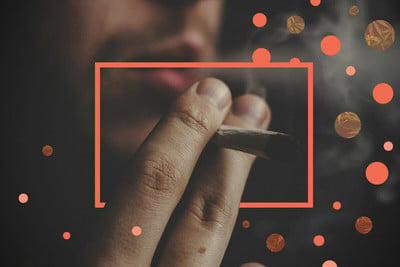.

Cannabis Tolerance Breaks: The Ultimate Guide
If you've smoked weed for quite some time, you'll know a thing or two about tolerance. Over time, the body downregulates cannabinoid receptors in response to constant exposure to THC. This means users have to smoke more to experience the same effects. Thankfully, taking a tolerance break can reset things. Find out everything you need to know here!
Contents:
- Factors that influence a weed tolerance break
- What is a tolerance break (t-break)?
- The most important question: why take a t-break?
- How long should a weed tolerance break last?
- Full t-break guide
- How often should I take a weed tolerance break?
- Will cbd ruin my tolerance break?
- You’re ready for a successful weed tolerance break
It can come out of nowhere. That strain that used to get you baked in a couple of hits no longer produces the same effect. No matter how much you smoke, you no longer feel the euphoric and creative effects of cannabis. Instead, every time you blaze, things seem rather flat and underwhelming. Why does this happen? Because your body has developed a tolerance to THC—the principal psychoactive component of weed. Fortunately, you don’t need to worry. Simply take a brief tolerance break, and you’ll reclaim the intensity you used to experience when you first started smoking.
Factors That Influence a Weed Tolerance Break
Not every cannabis user reaches a point of diminishing returns. Some casual smokers can enjoy cannabis for years at a time without noticing much of a difference in the highs they experience. Ultimately, several factors will determine whether you can benefit from a tolerance break. These include individual biology, how much cannabis you use and how often, and the THC content of your chosen strains. Furthermore, these factors, among others, will also influence the trajectory of your weed tolerance break if you eventually take one.
How Much and How Often You Smoke
Using THC-rich cannabis frequently and in large amounts causes your endocannabinoid system (ECS) receptors, specifically CB1, to downregulate, which manifests in dampened highs. Smoking large amounts infrequently will also eventually change the way your body responds to cannabinoids. Although regular smokers benefit the most from tolerance breaks, they also tend to find the process harder due to, albeit relatively mild, withdrawal symptoms. Moreover, regular smokers will require a longer period of abstinence to restore their CB1 receptors to a baseline than occasional smokers.


THC Content
The THC levels of the cannabis cultivars you smoke, vape, or otherwise ingest play a significant role in cannabis tolerance, and therefore in tolerance breaks. Regularly smoking strains with THC levels of 30% will build your tolerance much faster than smoking strains containing 15% THC. Typically, as users increase consumption over time, they also opt for increasingly more potent strains to deliver comparable effects. This, however, only works for so long before returns diminish. Many users also make the jump from buds to concentrates, which exhibit THC levels ranging from 50–90% and above, and establish a very high tolerance as a result.


Method of Ingestion
There are various ways to consume cannabis, including smoking, vaping, oral consumption, and sublingual intake. Each route of administration has a different bioavailability, onset, duration, and effect, with edibles producing the most intense psychoactive experience. However, overall, the method of ingestion doesn’t hold as much sway over cannabis tolerance as the strength and dosage of the product. For example, a person dabbing concentrates daily will likely need a tolerance break much sooner than a person who microdoses cannabis edibles from time to time.


Exercise
By exercising regularly, you can clear the lingering THC from your system while boosting your metabolism and releasing feel-good chemicals. Simply going for a run, cycle, or brisk walk can have a strong influence on a tolerance break by activating the ECS. Aerobic exercise, in particular, causes a release of compounds that bind to the same receptors as THC. Though these endogenous molecules bind with less affinity than the psychoactive cannabinoid, they are strong enough to induce the so-called “runner’s high”. Maintaining a good exercise regimen during your tolerance break can help you come down lightly and potentially process THC faster.


Sex and Hormones
The research behind how cannabis affects the sexes remains early and inconclusive. However, ongoing animal studies[1] suggest that females develop tolerance much more rapidly than males. Therefore, females might find themselves needing more cannabis over a shorter period of time to experience the same effects, meaning heavy female users may require more frequent tolerance breaks than heavy male users.


What Is a Tolerance Break (T-Break)?
A tolerance break simply refers to abstaining from cannabis for a certain period with the goal of restoring the body’s sensitivity to the effects of THC. It doesn’t require anything complicated; adherents simply stop smoking, vaping, dabbing, or taking edibles for a set period of time to allow their ECS to reset. It sounds easy enough, right? But things can get quite challenging, especially for those who use cannabis as a daily staple.
The Most Important Question: Why Take a T-Break?
Upon consuming THC, the cannabinoid binds to CB1 receptors in the brain, resulting in a surge of dopamine and the sensations of the cannabis high. As mentioned briefly above, over time, the ECS adapts to constant THC exposure by downregulating CB1 receptor expression. With fewer receptors, there are fewer sites for THC to activate. Despite smoking more and more herb, cannabis users will find themselves experiencing less potent effects. Taking a tolerance break gives the ECS time to rest and bring CB1 receptor expression back to normal levels.
How Long Should a Weed Tolerance Break Last?
How long does it take for weed tolerance to go back to normal? There are many different variables at play here, from how much weed a person uses, and for how long, down to their individual biology. A lack of formal studies in this area also makes it a case of individual experimentation. However, most infrequent users report that a period of a week or so helps to reset their ECS and enables them to experience cannabis in its full glory once again. For regular users, a period of two to three weeks is advised.
Full T-Break Guide
Below, we will show you how to successfully take a break from weed. You’ll discover a wealth of tips to keep you on the straight and narrow, from staying busy to resting properly and exercising. Although this guide only covers around one week, more frequent users can adapt these tips to a longer T-break if necessary.
Step 1 — Day 0: Preparation
Arguably the most important part of the process, step 1 involves undertaking a big overhaul of your daily life. First things first; get rid of all the weed in your house. Give it away for friends to use, or ask them to keep it untouched until you’ve finished your tolerance break. It’ll also help to tell several friends of your intentions and ask for their support during the process.


Step 2 — Day 1: Stay Busy
Even at this point, you might start to feel lost. A lot of people smoke weed as a standalone activity. Without it, you might find yourself with a lot of free time on your hands. So try to stay busy! Dive into your new hobby, cook meals from scratch, or head to the gym. If you’re really stuck for things to go, grab your headphones, put on a podcast, and go outside and walk until you hit 10,000 steps.


Step 3 — Day 2: Sleep Well, Read, Talk, and Relax
You’ll probably start to experience the initial signs of withdrawal at this point, including irritability, loss of focus, and headaches. In response, you need to treat your body with respect. Get a full eight hours of sleep at night, brew up some tea, read a book, and simply relax. If you’re struggling, give a close friend or family member a call and have a good talk—it’ll help more than you can imagine!


Step 4 — Day 3: Cook Delicious Food as a Reward
You’re making some serious progress, so treat yourself! Cooking up a delicious dinner for yourself will keep you busy and make you feel better in numerous ways. First, having a belly full of tasty food will simply make you merry! Second, you can select certain ingredients that could help to make withdrawal easier. Ongoing animal studies[2] are looking to see if beta-caryophyllene[3]—a dietary terpene found in cloves and rosemary—helps to attenuate addiction through CB2 receptor activation.


Step 5 — Day 4: Exercise
If the benefits of exercise existed in pill form, doctors would prescribe it to everyone! Exercise keeps the body healthy and toned, boosts mood, and releases a cocktail of chemicals throughout the body that makes us feel better. As mentioned, aerobic exercise boosts circulating levels of endocannabinoids, including the “bliss molecule” anandamide. Going for a run, cycle, swim, or walk offers a natural high without lighting up a joint.


Step 6 — Day 5: Face Your Withdrawal Symptoms
Some cannabis users will have already experienced the worst of their withdrawal symptoms by this point. Others, however, will experience the peak at around day 5. Overall, cannabis withdrawal symptoms include:
- Reduced appetite
- Mood changes
- Irritability
- Chills
- Cold sweats
- Stomach issues
- Headaches
- Sleeping difficulties


Not everybody will experience all of these symptoms; you may only experience one or two. Either way, you’ll still have to maintain the willpower to ride them out. To make things more bearable, try to consume three full, healthy meals each day, stay hydrated, sleep well, and exercise as much as you can.
Step 7 — Day 6: Connect With Yourself
We’ve covered a lot of physical strategies that help during a T-break. But we’re more than our bodies. It’ll also help to go inward to nurture your mind. Use this time to reflect on life, what holds you back, and where you want to go in the future. Meditate, go for contemplative walks, journal, and attempt to reconcile any lingering wrongs you have with other people. You’ll come out the other side a whole new person.


Step 8 — Day 7: Celebrate What You’ve Accomplished
You made it one entire week! Your withdrawal symptoms have mostly subsided, your cravings are down, and your ECS has started to express more CB1 receptors! But things aren’t over yet. If you push it a few more days, you’ll get to experience THC like it’s the first time all over again. Until then, you should feel proud of what you’ve achieved and have a little celebration. Count the money you’ve saved and splash it out on your new hobby, or save it for when you want to grab some bud in a few days' time.
Step 9 — Day 8: Repeat If You Need More Time Away From Weed
The road ends here for moderate users. If you blaze only a few times each week, you’ll have bolstered your CB1 receptors sufficiently. Finish your tasks for the day, invite some friends over, and fire up those bongs! If, however, you smoke heavily every single day, you’ll benefit from another week or two of abstinence. With your withdrawal symptoms gone, you’ll have a much easier time during subsequent weeks. Dive even deeper into your new hobby, keep treating yourself right, and don’t stop exercising—you’ll get to the finish line in no time.


How Often Should I Take a Weed Tolerance Break?
Again, this all depends on the individual. If you go straight back to using cannabis heavily and frequently, you’ll notice your tolerance increase over the next few weeks or months. If you enjoy a joint only on occasion, you won’t feel much of a difference in your highs.
Ultimately, if you feel that you aren’t getting the desired effects from using cannabis, consider taking a tolerance break to reset your system.
Will CBD Ruin My Tolerance Break?
No. Using CBD products during a tolerance break will not adversely affect CB1 receptor expression or cannabis tolerance. Interestingly, early research[4] shows that CBD might indirectly boost levels of anandamide, which, if consistently replicated in humans, could be utilised to manage withdrawal symptoms and make a weed tolerance break easier to handle.
You’re Ready for a Successful Weed Tolerance Break
You’re now aware of everything you need to know to take a T-break and reset your ECS. Whether it takes one week or more, you’ll quickly find that you can enjoy cannabis in all its grandeur once again. No longer will you have to settle for subpar highs and boring smoking sessions. Instead, after those first few hits, you’ll enjoy a surge of dopamine, creative thoughts, and euphoria!
- Rapid Changes in CB1 Receptor Availability in Cannabis Dependent Males after Abstinence from Cannabis - PubMed https://www.ncbi.nlm.nih.gov
- Cannabidiol is a negative allosteric modulator of the cannabinoid CB1 receptor - PubMed https://www.ncbi.nlm.nih.gov
- https://www.sciencedirect.com/science/article/pii/S0376871613002962
- Cannabidiol enhances anandamide signaling and alleviates psychotic symptoms of schizophrenia - PMC https://www.ncbi.nlm.nih.gov








































